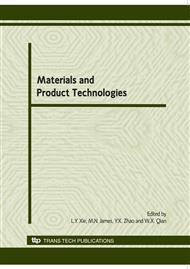[1]
A. Carpinteri, A. Spagnoli and S. Vantadori: Int. J. Fatigue Vol. 31 (2009), p.188.
Google Scholar
[2]
J. Li, Z.P. Zhang, Q. Sun, C.W. Li and Y.J. Qiao: Int. J. Fatigue Vol. 31 (2009), p.776.
Google Scholar
[3]
A. Cristofori, L. Susmel and R. Tovo: Int. J. Fatigue Vol. 30 (2008), p.1646.
Google Scholar
[4]
Y.L. Lee, T. Tjhung and A. Jordan: Int. J. Fatigue Vol. 29 (2007), p.1162.
Google Scholar
[5]
A. Ahmadi and H. Zenner: Int. J. Fatigue Vol. 28 (2006), p.954.
Google Scholar
[6]
M. Kueppers and C.M. Sonsino: Int. J. Fatigue Vol. 28 (2006), pp.540-546.
Google Scholar
[7]
A. Bernasconi, M. Filippini, S. Foletti and D. Vaudo: Int. J. Fatigue Vol. 28 (2006), p.663.
Google Scholar
[8]
X. Chen, D. Jin and K.S. Kim: Int. J. Fatigue Vol. 28 (2006), p.289.
Google Scholar
[9]
A.G. Camilla, A.A. Jose and N.M. Edgar: Int. J. Fatigue Vol. 27 (2005), p.177.
Google Scholar
[10]
A. Carpinteri and A. Spagnoli: Int. J. Fatigue Vol. 23 (2001), p.135.
Google Scholar
[11]
A. Spagnoli: Int. J. Mechanical Sciences Vol. 43 (2001), p.2581.
Google Scholar
[12]
K.C. Liu and J. A. Wang: Int. J. Fatigue Vol. 23 (2001), p.129.
Google Scholar
[13]
J.F. Bonnen, F.A. Conle and T.H. Topper: Int. J. Fatigue Vol. 23 (2001), p.385.
Google Scholar
[14]
A. Varvani-Farahani: Int. J. Fatigue Vol. 22 (2000), p.295.
Google Scholar
[15]
J. Ziebs, J. Meersmann, H.J. Kuhn, et al, in: Multiaxial Fatigue and Design, ESIS 21, Mechanical Engineering Publications, London (1996), p.173.
Google Scholar
[16]
M.S. Found, U.S. Fernando and K.J. Miller, in: Multiaxial Fatigue, ASTM, Philadelphia (1985), p.11.
Google Scholar
[17]
M.W. Brown and K.J. Miller, in: Multiaxial Fatigue, ASTM, Philadelphia (1985), p.135.
Google Scholar
[18]
M.W. Brown and K.J. Miller, in: Low-Cycle Fatigue and Life Prediction, ASTM, Philadelphia (1982), p.482.
Google Scholar
[19]
Y.S. Garud: J. Test Eval. Vol. 9 (1981), p.165.
Google Scholar
[20]
K. Rahka and C. Laird: J. Test Eval. Vol. 14 (1986), p.173.
Google Scholar
[21]
F. Ellyin, K. Golos and Z. Xia: Trans. ASME J. Engng. Mater. Technol. Vol. 113 (1991), p.112.
Google Scholar
[22]
A. Karolczuk and E. Macha: Engineering Fracture Mechanics Vol. 75 (2008), p.389.
Google Scholar
[23]
Y.Y. Wang and W.X. Yao: Int. J. Fatigue Vol. 4 ( 2006), p.401.
Google Scholar
[24]
T.E. Langlais, et al: Int. J. Fatigue vol. 25 (2003), p.641.
Google Scholar
[25]
X. Chen, S.Y. Xu and D.X. Huang: Fatigue Fract. Eng. Mater. Struct. Vol. 22 (1999), p.679.
Google Scholar
[26]
I.V. Papadopoulos: Int. J. Fatigue vol. 19 (1997), p.219.
Google Scholar
[27]
X. Pitoiset, I. Rychlik and A. Prenmort: Fatigue Fact. Engng. Mater. Stuct. 24 (2001), p.715.
Google Scholar
[28]
S.H. Stefanov: Int. J. Fatigue Vol. 17 (1995), p.567.
Google Scholar
[29]
F. Morel, et al: Int. J. Fatigue Vol. 25 (2003), p.1007.
Google Scholar
[30]
M.W. Brown, and K.J. Miller: Proc. Inst. Mechanical Engineers Vol. 187 (1973), p.745.
Google Scholar
[31]
F.A. Kandil, M.W. Brown and K.J. Miller: The Metals Society Vol. 280 (1982), p.205.
Google Scholar
[32]
A. Fatemi and D.F. Socie: Fatigue Eng. Mater. Struct Vol. 11 (1988), p.149.
Google Scholar
[33]
A. Fatemi and D.F. Socie, in: Fatigue Science and Tech., Kluwer Academic Publishers (1989).
Google Scholar
[34]
K.N. Smith, P. Watson and T.H. Topper: Journal of Materials Vol. 5 (1970), p.767.
Google Scholar
[35]
J.A. Bannantine and D.F. Socie, in: Fatigue under Biaxial and Multiaxial Loading, Mechanical Engineering Publication, London (1991), p.35.
Google Scholar
[36]
A. Carpinteri, et al: Int. J. Fracture Vol. 115 (2002), p.87.
Google Scholar
[37]
L. Wang and D.J. Wang: Chinese J. Mechanical Engineering Vol. 18 (2005), p.145.
Google Scholar
[38]
C.H. Wang and M.W. Brown: Fatigue Fract. Eng. Mater. Struct. Vol. 16 (1993), p.1285.
Google Scholar
[39]
C.H. Wang and M.W. Brown: J. Eng. Mater. Tech. Vol. 118 (1996), p.367.
Google Scholar
[40]
D.G. Shang, D.J. Wang, H. Xu and A. Ping: Acta Mechanical Solid Silica Vol. 11 (1998), p.261.
Google Scholar
[41]
A. Murat and C. Mehmet: Mechanical Systems and Signal Processing Vol. 23 (2009), p.897.
Google Scholar
[42]
M. Iranpour, F. Taheri and J. Kim Vandiver: Marine Structures Vol. 21 (2008), p.353.
Google Scholar


